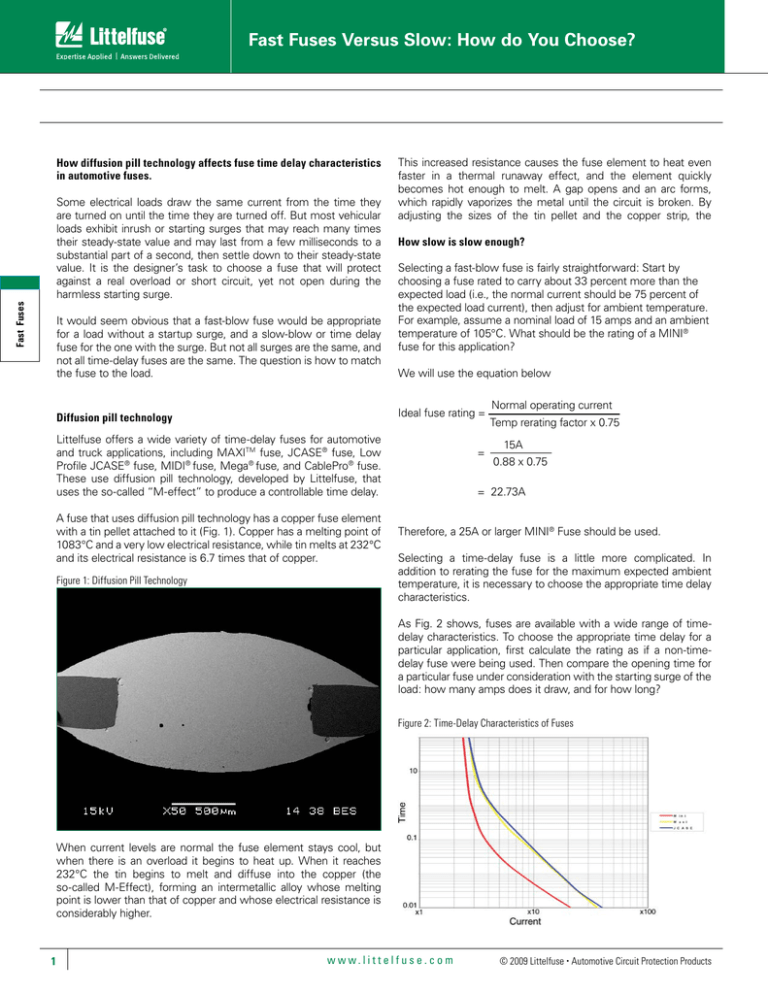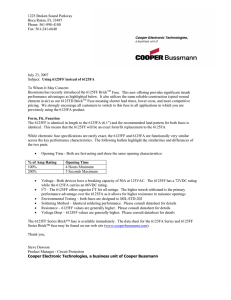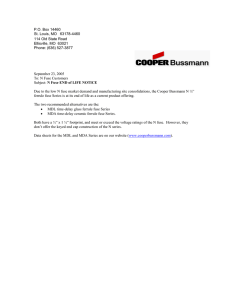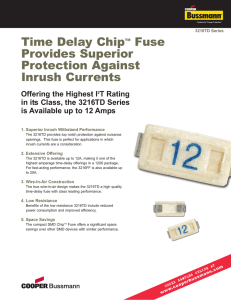Fast Fuses Versus Slow: How do You Choose?
advertisement

Fast Fuses Versus Slow: How do You Choose? How diffusion pill technology affects fuse time delay characteristics in automotive fuses. Fast Fuses Some electrical loads draw the same current from the time they are turned on until the time they are turned off. But most vehicular loads exhibit inrush or starting surges that may reach many times their steady-state value and may last from a few milliseconds to a substantial part of a second, then settle down to their steady-state value. It is the designer’s task to choose a fuse that will protect against a real overload or short circuit, yet not open during the harmless starting surge. It would seem obvious that a fast-blow fuse would be appropriate for a load without a startup surge, and a slow-blow or time delay fuse for the one with the surge. But not all surges are the same, and not all time-delay fuses are the same. The question is how to match the fuse to the load. This increased resistance causes the fuse element to heat even faster in a thermal runaway effect, and the element quickly becomes hot enough to melt. A gap opens and an arc forms, which rapidly vaporizes the metal until the circuit is broken. By adjusting the sizes of the tin pellet and the copper strip, the How slow is slow enough? Selecting a fast-blow fuse is fairly straightforward: Start by choosing a fuse rated to carry about 33 percent more than the expected load (i.e., the normal current should be 75 percent of the expected load current), then adjust for ambient temperature. For example, assume a nominal load of 15 amps and an ambient temperature of 105°C. What should be the rating of a MINI® fuse for this application? We will use the equation below Ideal fuse rating = Diffusion pill technology Littelfuse offers a wide variety of time-delay fuses for automotive and truck applications, including MAXITM fuse, JCASE® fuse, Low Profile JCASE® fuse, MIDI® fuse, Mega® fuse, and CablePro® fuse. These use diffusion pill technology, developed by Littelfuse, that uses the so-called “M-effect” to produce a controllable time delay. A fuse that uses diffusion pill technology has a copper fuse element with a tin pellet attached to it (Fig. 1). Copper has a melting point of 1083°C and a very low electrical resistance, while tin melts at 232°C and its electrical resistance is 6.7 times that of copper. Figure 1: Diffusion Pill Technology = Normal operating current Temp rerating factor x 0.75 15A 0.88 x 0.75 = 22.73A Therefore, a 25A or larger MINI® Fuse should be used. Selecting a time-delay fuse is a little more complicated. In addition to rerating the fuse for the maximum expected ambient temperature, it is necessary to choose the appropriate time delay characteristics. As Fig. 2 shows, fuses are available with a wide range of timedelay characteristics. To choose the appropriate time delay for a particular application, first calculate the rating as if a non-timedelay fuse were being used. Then compare the opening time for a particular fuse under consideration with the starting surge of the load: how many amps does it draw, and for how long? Figure 2: Time-Delay Characteristics of Fuses When current levels are normal the fuse element stays cool, but when there is an overload it begins to heat up. When it reaches 232°C the tin begins to melt and diffuse into the copper (the so-called M-Effect), forming an intermetallic alloy whose melting point is lower than that of copper and whose electrical resistance is considerably higher. 1 www.littelfuse.com © 2009 Littelfuse • Automotive Circuit Protection Products Fast Fuses Versus Slow: How do You Choose? For example, Fig. 3 shows that a 30A MINI® fuse subjected to a 100A overcurrent will open in about 0.1 seconds, while a 30A MAXITM fuse under the same overload will open in about 2.2 seconds. Let us assume that the load draws the same current as in the previous example, but has a starting surge of 50A that lasts for 1 second. MAXI TM fuse gates (Maximum/Minimum Opening Times) % of rating 20A 25A 30A 35A 40A 50A 60A 70A 80A 135 1800 1800 1800 1800 1800 1800 1800 3600 3600 60 60 60 60 60 60 60 60 20 30 30 40 40 50 60 60 60 4 4 6 6 8 10 15 4 4 2 4 4 5 5 6 7 2 2 0.7 0.7 1 1 1.4 1.7 2 0.20 0.20 1 1 1 1 1 1 1 1 1 0.15 0.15 0.20 0.20 0.20 0.20 0.20 .1 .1 200 Figure 3: MINI® Fuse T-C Characteristics 350 600 Fast Fuses 60 The tables below give gate values for other Littelfuse time-delay automotive fuses. MIDI® fuse gates (Maximum/Minimum Opening Times) % of rating 100 110 150 200 300 30-125A 150-200A 100 h 4h 1 hr 90 s 100 s 15 s 5s 1s 15 s 3s 0.5s 0.3 s JCASE® fuse gates (Maximum/Minimum Opening Times) We use the same calculation as with the MINI® fuse, to determine that the basic rating of our fuse should be 25A. While we used the delay curves as a preliminary indication it is important to know that such curves are averages and not guaranteed; for guarantees we use tables of maximum and minimum delay values (also called time-current gates or TC gates). We can see in the table below that a MAXITM fuse rated at 25A will carry 200 percent of its rated load for a minimum of 4 seconds and a maximum of 30 seconds, so it is a good choice in this application. © 2009 Littelfuse • Automotive Circuit Protection Products % of Rating Opening Time Min / Max (s) 110 100 h / – 135 60 s / 1800 s 200 4 s / 60 s 350 200 ms / 7 s 600 40 ms / 1 s www.littelfuse.com 2 Fast Fuses Versus Slow: How do You Choose? Fast fuses versus slow: How do you choose? Thermal cycling Fast Fuses Thermal cycling applies to all fuse technologies and in fact to all materials but may be considered especially important to fuses with the active mechanism of diffusion pill technology. While the diffusion pill design makes for a very effective time-delay fuse, what happens if the overcurrent does not last long enough to blow the fuse? Each time a short overcurrent pulse flows through the fuse the element will heat up, and some tin-copper diffusion will take place, permanently changing the characteristics of the element. With enough pulses the fuse will eventually fail. If there is some question as to whether a particular fuse type will survive in a pulsed application, then it is best to perform an I2T analysis. I2T (“I squared T”), expressed in ampere2 seconds is a measure of the total energy dissipated in the fuse during a pulse. This involves calculating the ratio of the applied I2T to the fuse’s nominal melting I2T, then looking at the table below and Fig. 4. Pulse cycle withstand capability Number of pulses Percent of nominal I2T 100,000 22 1000 38 100 48 600 40 ms / 1 s Littelfuse provides a separate application note that provides full instructions on doing an I2T analysis. 3 www.littelfuse.com © 2009 Littelfuse • Automotive Circuit Protection Products



